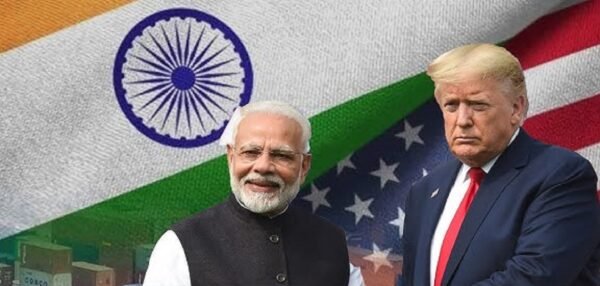Trump Tariffs will lead Job Losses in Indian Service Sectors?

The imposition of tariffs by the U.S. under President Donald Trump is likely to have significant impacts on various sectors in India, including service sectors. Here’s how these tariffs could lead to job losses in Indian service sectors:
Impact on Indian Service Sectors
IT Sector:
Job Losses and Hiring Slowdown: The IT sector, a major service exporter to the U.S., is facing uncertainty due to Trump’s tariffs. While the tariffs do not directly affect IT services, the economic instability and potential recession in the U.S. could lead to reduced demand for IT services. This may result in a hiring slowdown and potential job losses as U.S. clients cut spending on IT services.
Economic Uncertainty: The tariffs have created economic uncertainty, which is affecting the IT sector’s growth. Companies are cautious about new hiring and are focusing on optimizing their workforce rather than expanding it.
Other Service Sectors:
Indirect Effects: While other service sectors may not be directly impacted by the tariffs, they could still face indirect effects due to the broader economic slowdown. For instance, sectors closely linked to manufacturing or trade might see reduced demand or slower growth.
Overall Impact on Indian Economy
GDP Impact: Estimates suggest that a broad tariff could reduce India’s GDP by about $31 billion, which is roughly 0.72% of the total GDP.
Trade Relations: The tariffs have strained trade relations between India and the U.S., potentially affecting various sectors beyond just services.
Trump’s tariffs do not directly target Indian service sectors like IT, the economic instability and potential recession they trigger could lead to job losses and hiring slowdowns in these sectors.
The impact of Trump’s proposed tariffs on the Indian service sector, particularly regarding job losses, is a complex issue that depends on various factors, including the specifics of the tariff policies, the sectors affected, and India’s economic response. While the tariffs announced as of April 3, 2025, primarily target goods rather than services, their indirect effects could still ripple through the Indian service sector, which includes IT, IT-enabled services (ITES), pharmaceuticals, and other key areas heavily reliant on U.S. markets.
The tariffs, ranging from 26% to 27% on Indian goods entering the U.S., aim to address perceived trade imbalances, with the U.S. citing India’s higher tariffs on American products (e.g., up to 52% on some goods). India’s service sector, which accounts for nearly half of its total exports and is a major employer, could face challenges not from direct tariffs on services but through secondary effects. For instance, the IT and ITES industries, which employ millions and generate significant revenue from U.S. clients (e.g., over 60% of India’s IT exports go to the U.S.), might see reduced demand if American companies face higher costs for imported goods, squeezing their budgets for outsourcing services.
If U.S. firms cut back on IT projects due to increased operational costs or economic uncertainty—potentially exacerbated by tariffs—Indian IT companies like TCS, Infosys, and Wipro could experience slower growth or project cancellations. This might lead to hiring freezes or layoffs, particularly in roles tied to back-office support, software development, and customer service. For example, a 15% cost increase for U.S. firms, as speculated in some analyses, could prompt a 10% reduction in outsourced projects, potentially affecting tens of thousands of jobs in India’s IT hubs like Bengaluru and Hyderabad.
Similarly, the pharmaceutical sector, while largely exempt from these reciprocal tariffs, could still see indirect pressure. India supplies nearly half of the U.S.’s generic drugs, and any broader trade tensions or retaliatory measures could disrupt supply chains or confidence, impacting ancillary service jobs in logistics, regulatory compliance, and sales support.
However, the scale of job losses is uncertain and debated. Some estimates suggest India’s GDP could dip by 0.05% to 0.7% due to export declines (e.g., $2-7 billion annually), with IT, pharma, and related services bearing part of the brunt. This might translate to job losses ranging from a few thousand to 1.5–2 million in extreme scenarios, as speculated in some posts on X, though such figures lack firm backing without detailed policy specifics. India’s low reliance on external demand (exports to the U.S. are just 2.2% of its GDP) and resilience in domestic consumption could cushion the blow, potentially limiting service sector job losses to a smaller fraction—perhaps in the tens of thousands rather than millions.
On the flip side, some argue the tariffs could boost outsourcing to India. As U.S. firms seek cost savings to offset tariff-driven expenses, they might shift more IT and back-office work to India, where labor costs remain lower. This could mitigate or even reverse job losses in the short term, though it hinges on India maintaining competitiveness amid global supply chain shifts.
Trump’s tariffs on goods could indirectly lead to job losses in India’s service sector, particularly in IT and ITES, due to reduced U.S. demand or economic slowdown. The extent—potentially ranging from minimal to significant (thousands to low millions)—depends on how U.S. companies adjust budgets, India’s trade negotiations, and domestic policy responses. Without direct tariffs on services, the impact is likely moderate rather than catastrophic, but vigilance and adaptability will be key for India’s service workforce.

